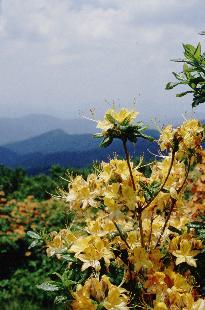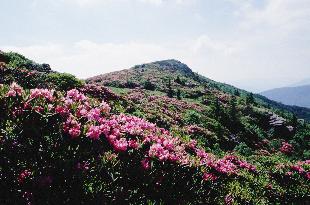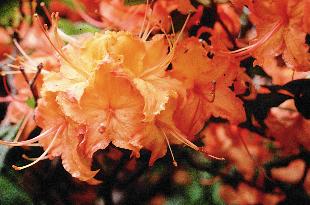


Next: The Hybrid Swarm on
Up: Favorite Locations
Previous: Favorite Locations
 For me, the best place to see R.calendulaceum in all its glory is along the
Appalachian Trail near Roan Mountain
at the North Carolina - Tennessee border. The combination of the native azaleas, wildflowers, and the mountain scenery make this special site one of the most beautiful places on earth. Starting up the Appalachian Trail at Carver's Gap, the path ascends several hundred feet to the top of Round Bald, elevation 5826 feet. The trail has recently been rerouted to discourage erosion, making the climb a bit longer and more scenic, and certainly less strenuous. From the top of Round Bald the view is spectacular. As the trail descends to the right toward Engine gap a magnificent display of calendulaceum begins, continuing all the way to the next ridge at Jane Bald. The peaks in this region are all from 5,000 to 6,000 feet in elevation, and because of variations in bloom time, this impressive native azalea display lasts through much of June with peak season probably the second or third week depending upon the year.
For me, the best place to see R.calendulaceum in all its glory is along the
Appalachian Trail near Roan Mountain
at the North Carolina - Tennessee border. The combination of the native azaleas, wildflowers, and the mountain scenery make this special site one of the most beautiful places on earth. Starting up the Appalachian Trail at Carver's Gap, the path ascends several hundred feet to the top of Round Bald, elevation 5826 feet. The trail has recently been rerouted to discourage erosion, making the climb a bit longer and more scenic, and certainly less strenuous. From the top of Round Bald the view is spectacular. As the trail descends to the right toward Engine gap a magnificent display of calendulaceum begins, continuing all the way to the next ridge at Jane Bald. The peaks in this region are all from 5,000 to 6,000 feet in elevation, and because of variations in bloom time, this impressive native azalea display lasts through much of June with peak season probably the second or third week depending upon the year.
 On the balds in this area there are also rare wild flowers such as the red Gray's Lily (Lilium grayi), and great masses of the lavender-purple rhododendrons, R. catawbiense. On a good year (and on a clear day), a side trip out to Grassy Ridge Bald affords one of the most dramatic sights imaginable. As the elevation rises gradually to a height of 6189 feet, a 360 degree view reveals the entire mountainside has turned purple from the rhododendron blossoms. Even when not in bloom, the majesty of this setting is an inspiration to all that walk along the trail. Words cannot describe the awe one feels standing on the top of the world surrounded by such incredible beauty. The U.S. Forest Service has placed a plaque on the mountain to honor the memory of local resident Cornelious Rex Peake (1887 - 1964). It reflects on the beauty of this spot and how much this man and his forefathers loved the Roan Mountain region. I hope there are people in our generation who will be similarly remembered as caring forefathers who loved and protected such solemn grounds.
On the balds in this area there are also rare wild flowers such as the red Gray's Lily (Lilium grayi), and great masses of the lavender-purple rhododendrons, R. catawbiense. On a good year (and on a clear day), a side trip out to Grassy Ridge Bald affords one of the most dramatic sights imaginable. As the elevation rises gradually to a height of 6189 feet, a 360 degree view reveals the entire mountainside has turned purple from the rhododendron blossoms. Even when not in bloom, the majesty of this setting is an inspiration to all that walk along the trail. Words cannot describe the awe one feels standing on the top of the world surrounded by such incredible beauty. The U.S. Forest Service has placed a plaque on the mountain to honor the memory of local resident Cornelious Rex Peake (1887 - 1964). It reflects on the beauty of this spot and how much this man and his forefathers loved the Roan Mountain region. I hope there are people in our generation who will be similarly remembered as caring forefathers who loved and protected such solemn grounds.
 One of my favorite forms of calendulaceum sits boldly near the ridge at Jane Bald. We refer to it as "Molten Lava" because of its brilliant golden orange color that contrasts so beautifully with the blue mountains in the distance. The flowers of "Molten Lava" are relatively large, usually over two inches across, and the edges are beautifully ruffled and frilled. Choosing a favorite form of calendulaceum is hard to do because there are so many lovely forms scattered along the edge of the bald from Engine Gap to Jane Bald. They come in all shades from clear yellow and gold, to blends of orange and deep orange-red. Dr. August Kehr reported seeing a double form of calendulaceum at Jane Bald but I have looked for that plant many times with no success. I fear that it may have been overgrown, lost, or possibly stolen.
One of my favorite forms of calendulaceum sits boldly near the ridge at Jane Bald. We refer to it as "Molten Lava" because of its brilliant golden orange color that contrasts so beautifully with the blue mountains in the distance. The flowers of "Molten Lava" are relatively large, usually over two inches across, and the edges are beautifully ruffled and frilled. Choosing a favorite form of calendulaceum is hard to do because there are so many lovely forms scattered along the edge of the bald from Engine Gap to Jane Bald. They come in all shades from clear yellow and gold, to blends of orange and deep orange-red. Dr. August Kehr reported seeing a double form of calendulaceum at Jane Bald but I have looked for that plant many times with no success. I fear that it may have been overgrown, lost, or possibly stolen.
In the past few years there has been noticeable damage from deer browsing on Roan. The deer are not only eating the native azaleas, but also the rhododendrons and rare wild flowers on the bald. Even more alarming is news that North Carolina is apparently trying to establish elk populations in the mountain regions. This will put even further stress on the native plants unless some natural balance is secured. In addition to animal damage, invasive plants are causing concern too since alder, blackberry, and various trees are crowding out the native azaleas and wildflowers. Each year, though, I see evidence that admiring visitors have tried to break back branches of the encroaching shrubs and trees giving these wildflowers another year to share their beauty with us. One interesting note is that calendulaceum plants tangled in blackberry and alder seem to show less deer damage than those in the open.



Next: The Hybrid Swarm on
Up: Favorite Locations
Previous: Favorite Locations
Donald W. Hyatt
2001-06-26
 For me, the best place to see R.calendulaceum in all its glory is along the
Appalachian Trail near Roan Mountain
at the North Carolina - Tennessee border. The combination of the native azaleas, wildflowers, and the mountain scenery make this special site one of the most beautiful places on earth. Starting up the Appalachian Trail at Carver's Gap, the path ascends several hundred feet to the top of Round Bald, elevation 5826 feet. The trail has recently been rerouted to discourage erosion, making the climb a bit longer and more scenic, and certainly less strenuous. From the top of Round Bald the view is spectacular. As the trail descends to the right toward Engine gap a magnificent display of calendulaceum begins, continuing all the way to the next ridge at Jane Bald. The peaks in this region are all from 5,000 to 6,000 feet in elevation, and because of variations in bloom time, this impressive native azalea display lasts through much of June with peak season probably the second or third week depending upon the year.
For me, the best place to see R.calendulaceum in all its glory is along the
Appalachian Trail near Roan Mountain
at the North Carolina - Tennessee border. The combination of the native azaleas, wildflowers, and the mountain scenery make this special site one of the most beautiful places on earth. Starting up the Appalachian Trail at Carver's Gap, the path ascends several hundred feet to the top of Round Bald, elevation 5826 feet. The trail has recently been rerouted to discourage erosion, making the climb a bit longer and more scenic, and certainly less strenuous. From the top of Round Bald the view is spectacular. As the trail descends to the right toward Engine gap a magnificent display of calendulaceum begins, continuing all the way to the next ridge at Jane Bald. The peaks in this region are all from 5,000 to 6,000 feet in elevation, and because of variations in bloom time, this impressive native azalea display lasts through much of June with peak season probably the second or third week depending upon the year.

